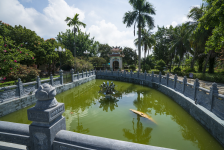
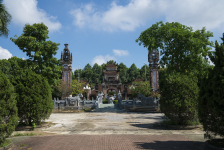
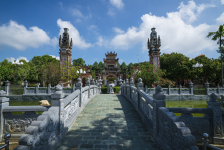
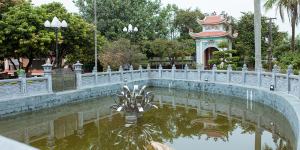
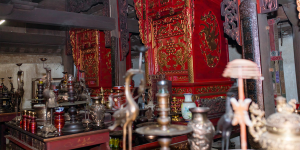
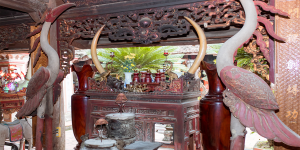
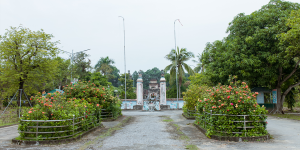
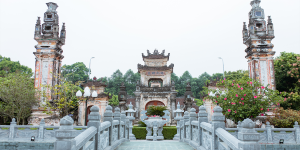
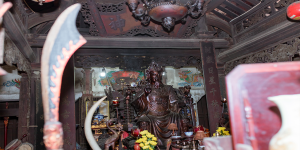
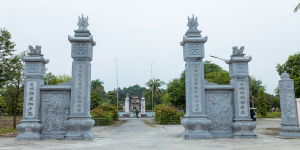
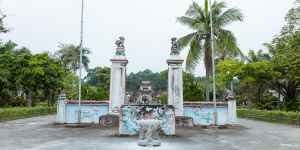
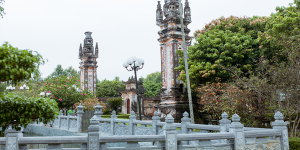
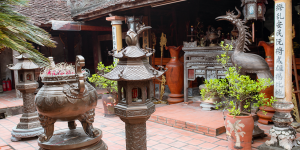
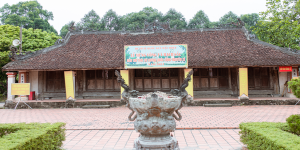
Camera tour
Price: Free
Time to visit a place: 120 phút
Open Time: 7:00 AM - Close Time: 6:00 PM
Address: Nghi Khanh Village, Nghi Loc District, Nghe An Province
NGUYEN XI TEMPLE
Temple of Thai Su Cuong Quoc Cong Nguyen Xi is an ancient temple with a relatively large scale that still exists on the land of Nghe An, where Nguyen Xi - a talented general, famous god of the Le So dynasty contributed part to glorify the homeland of Nghe An. Through many ups and downs of time, the temple still retains its majesty and magnificence with its unique architecture.
Nguyen Xi was born in the year of the Ding Buffalo (1397) in Thuong Xa village, Chan Phuc district, Hoan Chau religion (now known as Nghi Hop commune, Nghi Loc district, Nghe An province), in a family of salt traders. After Le Loi raised the flag of insurrection to repel the invading Minh invaders, he and his brother Nguyen Bien were the first people to join the Lam Son insurgent army. With a smart and agile personality, he was soon noticed by Le Loi and trained to become a talented general. His name was associated with many glorious battles against the Ming invaders at that time such as the battle of Tot Dong and Xuong Giang, ......
In the year of the Wu Monkey (1428), Le Loi ascended to the throne, Nguyen Xi was considered as the "khai quốc công thần" (servant has great merit in building country), ranked 5th in the 9 ranks of people with great merit, granted national status, "a mainstay" under the 4 dynasties of King Le (Thai To, Thai Tong, Nhan Tong, Thanh Tong) with many important titles such as “Long Hổ tướng quân suy trung bảo chính công thần, Khai quốc suy trung dương võ minh nghĩa phụ quốc tá lý tịnh nạn trung hưng công thần Á quận hầu, Sái quận công, Nhập nội tướng quốc, Thái úy”... Nguyen Xi is not only an outstanding general but also a politician with a clear vision. Living and operating right in the middle of a place full of uncertainties, a series of servants having great merit in building country were falsely accused and harmed, even Nguyen Trai could not save his life, but still, Nguyen Xi still overcame everything, especially defeating the rebel factions, deposed Le Nghi Dan, and brought Prince Le Tu Thanh to the throne, ie King Le Thanh Tong - the most intelligent king of the Le So dynasty - what Nguyen Trai always wanted. Therefore, the history called him as "the man who founded the country twice".
He died on 30th October, Year of the Yi Rooster (1465), his body was buried in his hometown in Thuong Xa village. King Le Thanh Tong mourned, did not come to court for 3 days, and posthumously awarded him the title "Thái sư Cương Quốc công đặc ân khai quốc". Commenting on the man, King Le Thanh Tong wrote "... When the country has an extraordinary changes, only you take care of the rescue. Father and son of one family, with one heart, destroy the wicked. The King-Servant relationship holds the sun and sets it high for thousands of years. Your merit is not inferior to the court of the Han Dynasty, more than the mandarins of the Duong Dynasty. Three mainstays are broken and it was connected again, the sun and moon had darkened, now it's light again...”.
Two years after his death, in the year of the Ding Big (1467), King Le Thanh Tong ordered the temple to be built under the "quốc tạo, quốc tế" regime. The temple was built on a large, high land. Behind is a majestic mountain complex including Mao mountain, Guom mountain, Con Thong mountain, Voi mountain as a fulcrum. The project has 3 upper, middle, and lower halls and many ancillary works such as three-door gate, bell tower, Khanh, left hall, right hall... However, through the fighting between the feudal groups Le - Mac, Trinh - Nguyen, the temple was seriously destroyed. By the Nguyen Dynasty, the works of the temple were restored and embellished in turn. Therefore, the temple is basically in the architectural style of the Nguyen Dynasty. Nguyen Xi, was ordained by the Le dynasty as "Thượng đẳng phúc thần, Hiển uy chính nghị anh liệt trung trinh đại vương", in the Nguyen dynasty, he was conferred as "supreme deity".
Currently, Nguyen Xi Temple is one of the large-scale temples of Nghe An province. Experiencing many ups and downs of time, the temple still retains its majesty and magnificence, many works such as the three-door gate, central hall built in a unique match stack architecture with many beautiful decorations and a system of valuable artifacts being kept at the relic.
Nguyen Xi Temple Festival takes place from 29th January to 01 February of the lunar calendar, attracting a large number of people and descendants of the Nguyen Dinh family clan from all over the country to attend. The festival is not only an opportunity for posterity to show respect and remembrance of the nation's outstanding deity, but also contribute to the education of patriotism and national pride for the young generations, contributing to building and promoting the cultural values of our people. In 1990, Nguyen Xi Temple was ranked as a national historical, cultural and architectural relic in Decision No. 34/QD-VH on January 9, 1990.
Distance: 3.20 km
Distance: 3.22 km
Distance: 3.25 km
Distance: 3.27 km
Distance: 3.28 km
Distance: 3.32 km
Distance: 3.32 km
Distance: 3.33 km
Distance: 3.35 km
Distance: 3.35 km
Distance: 3.36 km
Distance: 3.36 km
Distance: 1.10 km
Distance: 1.90 km
Distance: 1.96 km
Distance: 2.40 km
Distance: 3.49 km
Distance: 3.50 km
Distance: 3.60 km
Distance: 3.65 km
Distance: 3.88 km
Distance: 4.03 km
Distance: 4.20 km
Distance: 4.40 km
Distance: 4.51 km
Distance: 4.81 km
Distance: 4.97 km
Distance: 5.19 km
Distance: 6.50 km
Distance: 6.67 km
Distance: 0 m
Distance: 250 m
Distance: 1.54 km
Distance: 1.86 km
Distance: 2.07 km
Distance: 2.07 km
Distance: 2.64 km
Distance: 2.80 km
Distance: 2.96 km
Distance: 3.22 km
Distance: 3.65 km
Distance: 3.93 km
Distance: 3.99 km
Distance: 4 km
Distance: 4.37 km
Distance: 4.95 km
Distance: 5.65 km
Distance: 7.20 km
Distance: 3.41 km
Distance: 3.53 km
Distance: 3.65 km
Distance: 3.72 km
Distance: 3.76 km
Distance: 3.82 km
Distance: 4.13 km
Distance: 4.22 km
Distance: 4.86 km
Distance: 5.63 km
Distance: 6.17 km
Distance: 6.39 km
Distance: 6.54 km
Distance: 6.98 km
Distance: 12.57 km



8
Vũ Vinh
29/11/2021 16:27Một điểm đến rất đẹp và ý nghĩa về lịch sử. Tôi rất thích nơi này